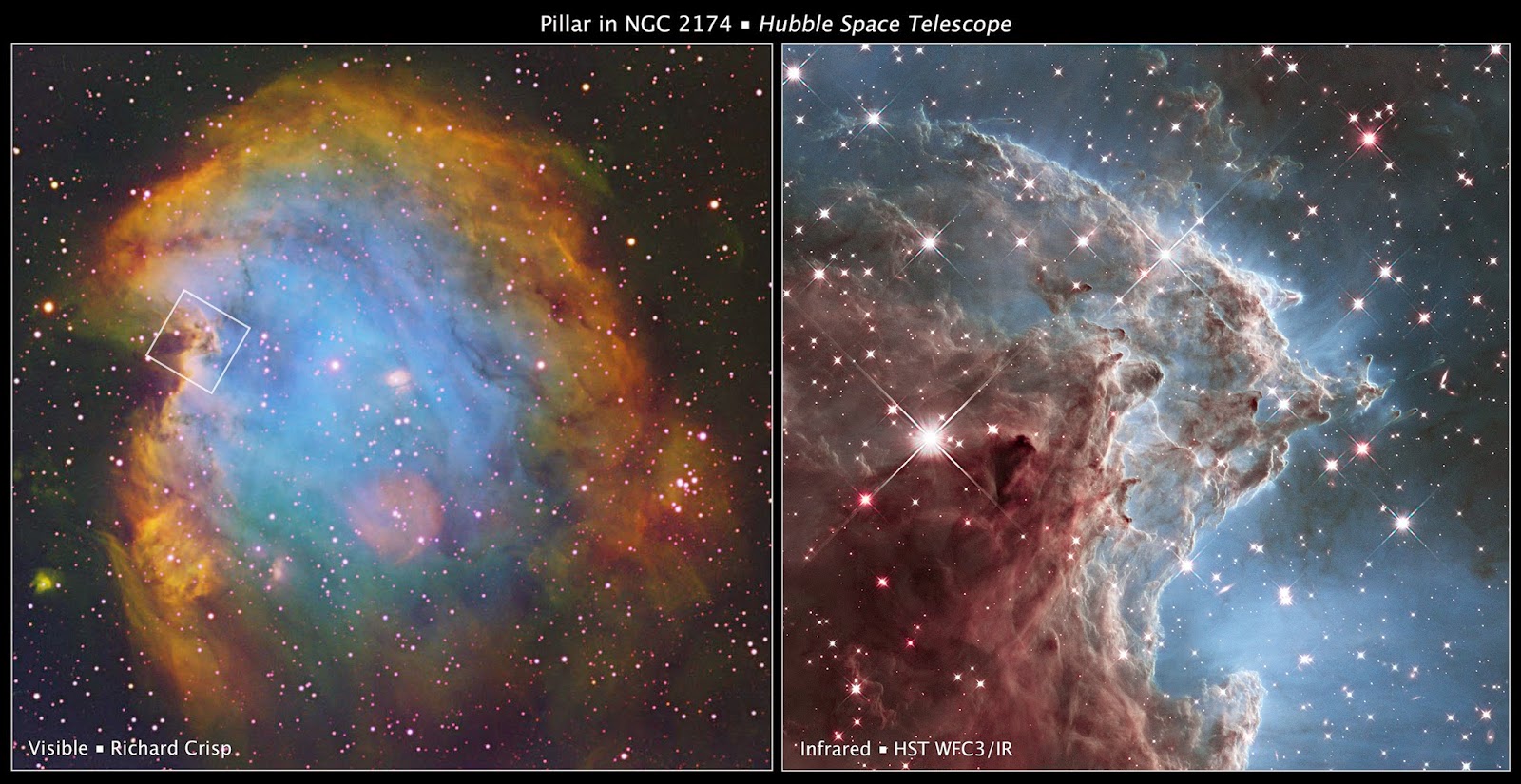A Passion for Understanding
The Laser Interferometer Gravitational-Wave Observatory could be
as significant an innovation as the telescope. This story of passionate
creative researchers striving to understand the fabric of our Universe
premieres Tuesday April 15 at Space.com.
Credit: Kai Staats
NGC 2174
The Hubble mosaic unveils a collection of carved knots of gas and dust in a small portion of the Monkey Head Nebula (also known as NGC 2174 and Sharpless Sh2-252). The nebula is a star-forming region that hosts dusky dust clouds silhouetted against glowing gas.
Credit: NASA, ESA, and the Hubble Heritage Team (STScI/AURA)
This graphic shows the location of the infrared image from the Hubble Space Telescope in a wider view of the region of NGC 2174. On the left is a ground-based image of the star-forming nebula in visible light by an amateur astrophotographer, with an outline showing the area of the detailed Hubble image. On the right is a small detail of a star-forming column in the nebula, made by Hubble's WFC3 infrared camera.
Credit: NASA and ESA; Acknowledgment: The Hubble Heritage Team (STScI/AURA) and R. Crisp
Credit: NASA, ESA, and the Hubble Heritage Team (STScI/AURA)
Mike Wall, Senior Writer space.com | March 19, 2014 05:04pm ET
NASA's Hubble Space Telescope has captured an amazing view of a distant starbirth factory, a nebula known as the "Monkey Head," to help celebrate the upcoming 24th anniversary of the iconic instrument's launch.
The new infrared mosaic from Hubble — which launched on April 24, 1990 — shows knotty curls of dust and gas in the Monkey Head Nebula, a star-forming region that lies about 6,400 light-years away from Earth and is also known as NGC 2174 and Sharpless Sh2-252. Scientists used the Hubble mosaic to create a spectacular video of the Monkey Head Nebula to explain the new cosmic views.
"Massive, newly formed stars near the center of the nebula (and toward the right in this image) are blasting away at dust within the nebula," Hubble officials wrote in a description of the image, which was captured in February and released on Monday (March 17). You can see more Monkey Head Nebula views here, along with other Hubble Space Telescope images.
"Ultraviolet light from these bright stars helps carve the dust into giant pillars. The nebula is mostly composed of hydrogen gas, which becomes ionized by the ultraviolet radiation," they added. "As the interstellar dust particles are warmed from the radiation from the stars in the center of the nebula, they heat up and begin to glow at infrared wavelengths."
Credit: NASA and ESA; Acknowledgment: The Hubble Heritage Team (STScI/AURA) and R. Crisp
Though the Hubble Space Telescope is famous today for its gorgeous cosmic images and contributions to astronomy in a number of fields, the mission had a bumpy start. Hubble launched to space with a primary mirror ground to the wrong prescription, and five space shuttle missions were required to repair and upgrade the huge instrument.
Hubble officials have said they hope to keep the telescope operating through at least 2020, ensuring some scientific overlap with its designated successor, NASA's infrared-optimized James Webb Space Telescope. The $8.8 billion JWST mission is currently scheduled to launch in 2018.
Follow Mike Wall on Twitter @michaeldwall
Galaxy ESO 137-001
As spiral galaxy ESO 137-001 zooms through the super hot gas of the Norma cluster, much of it's own gas is pulled away in a process called 'ram pressure stripping. The threads of gas left behind give birth to bright young stars, seen here in blue.
Credit: NASA


